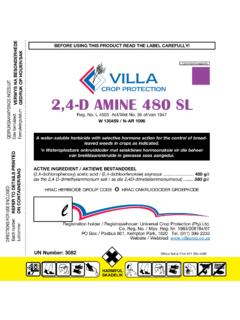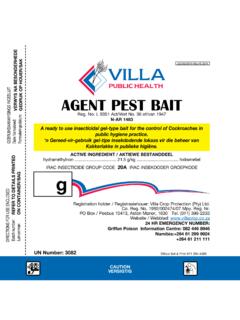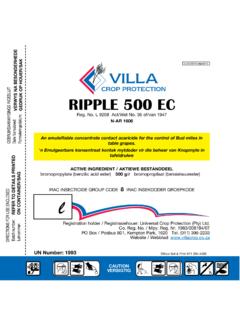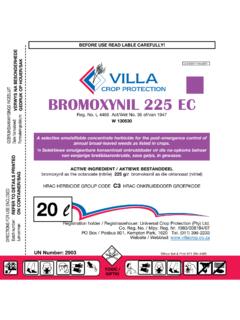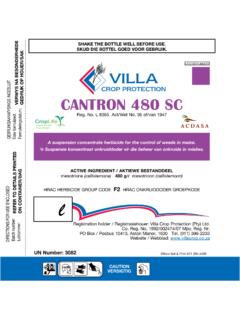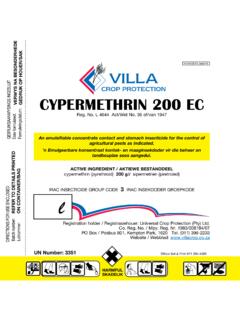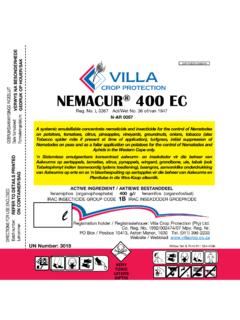Transcription of RIPPLE 500 EC Rev 2 - Villa Crop
1 UNIVERSAL Crop Protection (Pty) Ltd Subject: RIPPLE 500 EC Co. Reg. No.: 1983/008184/07 Document no: 224UN Effective Date: November 2011 Revision no: November 2013 (2) Product Code: INSERIPPLE500EC/UN UNIVERSAL RIPPLE 500 EC MATERIAL SAFETY DATA SHEET Page 1 of 4 1. PRODUCT & COMPANY IDENTIFICATION Product Name: RIPPLE 500 EC Insecticide UN No.: 1993 Supplier: Universal Crop Protection (Pty) Ltd. PO Box 801, Kempton Park, 1620, South Africa Telephone: (011) 396 2233 Fax: (011) 396 4666 Website: Emergency telephone: (011) 396 2233 24 Hr Emergency Numbers: Bateleur: 083 1233 911 or (Client: Villa Crop Protection) 0860 333 911 In case of Poisoning: Red Cross Poison Information Centre: 021 689 5227 Tygerberg Poison Information Centre: 021 931 6129 Griffon Poison Information Centre: 082 446 8946 2.
2 COMPOSITION/INFORMATION ON INGREDIENTS Common Name: Bromopropylate Chemical Name: 1-methylethyl-4-bromo- (4-bromophenyl)- -hydroxybenzeneacetate CAS No.: 18181-80-1 Chemical Family: Benzilate Chemical Formula: C17H16Br2O3 (Mol. wt.: ) Use: Control of all stages of tetranychid & eriophyid mites on vines & other crops. Mode of Action: Non-systemic acaricide with contact action, and long residual activity. Formulation: Bromopropylate: 500 g/l Emulsifiable Concentrate Hazardous Ingredient: Chemical Name CAS Number g/llll (w/v) Bromopropylate 18181-80-1 500 g/l Xylene 1330-20-7 Balance Other Inerts 390 g/l SYMBOLS: T, N, Xi, F RISK-PHRASE(S): R10, R36/38, R51/53, R61 3.
3 HAZARD IDENTIFICATION Main hazard: May cause harm to unborn child. Flammable. Irritating to eyes & skin. Very toxic to aquatic organisms may cause long-term adverse effects in the aquatic environment. Likely routes of exposure: Swallowing. Skin contact: Moderate irritant to skin. Eye contact: Slight irritant to eyes. Skin sensitisation: Not a skin sensitizer. Ingestion: Harmful by ingestion. No significant adverse effects are expected to develop when used as recommended. 4. FIRST AID MEASURES AND PRECAUTIONS Inhalation: Remove from exposure area to fresh air immediately. If breathing has stopped, administer artificial respiration.
4 Keep patient warm and at rest. Treat symptomatically and supportively. Get medical attention if necessary. Skin contact: Remove contaminated clothing, leather goods and shoes immediately. Wash affected area with large amounts of water (approximately 15 to 20 minutes). Get medical attention if necessary. Wash contaminated clothing before re-use. Eye contact: Remove contact lenses, if present, after the first 5 minutes, and then continue rinsing the eye with large amounts of water, occasionally lifting upper and lower lids, until no evidence of chemical remains (approximately 15 to 20 minutes). Immediate medical attention is required.
5 Ingestion: Get medical attention immediately and make this document or label available to him. Never give anything to an unconscious person. Do not induce vomiting: contains petroleum distillates and/or aromatic solvents. Note to physician: Antidote: There is no specific antidote available. Treat symptomatically. DO NOT INDUCE VOMITING: contains petroleum distillates and/or aromatic solvents. 5. FIRE FIGHTING MEASURES Fire and explosion hazard: Flammable. Flash point: C Suitable Extinguishing media: Use water spray, alcohol-resistant foam, carbon dioxide, or dry chemical powder. Unsuitable extinguishing media: Do not use a solid water stream as it may scatter and spread fire.
6 Hazardous products of combustion: Combustion or thermal combustion will evolve toxic and irritant vapors. Fire fighting: Remove spectators from surrounding area. As the product contains combustible organic components, fire will produce dense black smoke containing hazardous UNIVERSAL Crop Protection (Pty) Ltd Subject: RIPPLE 500 EC Co. Reg. No.: 1983/008184/07 Document no: 224UN Effective Date: November 2011 Revision no: November 2013 (2) Product Code: INSERIPPLE500EC/UN UNIVERSAL RIPPLE 500 EC MATERIAL SAFETY DATA SHEET Page 2 of 4 products of combustion. Exposure to decomposition products may be a hazard to health.
7 Flash back possible over considerable distance. Use a recommended extinguishing agent. Avoid inhaling hazardous vapours. Avoid pollution of waterways. Personal protective equipment: Fire-fighters and others that may be exposed should wear full protective clothing and self-contained breathing apparatus. 6. ACCIDENTAL RELEASE MEASURES (SPILLAGE) Personal precautions: Keep people away from and upwind of spill/leak. Beware of vapours accumulating to form explosive concentrations. Vapours can accumulate in low areas. Remove all source of ignition. Avoid contact with skin and eyes. For personal protection see Section 8. Environmental precautions: Prevent further leakage or spillage if safe to do so.
8 Do not allow entering drains or watercourses. Any Spillage or uncontrolled discharges into water courses (or public waters) to be reported immediately to the Police and to the Department of Water/Environmental Affairs. Methods for cleaning up: Contain spillage, and then collect with non-combustible absorbent material, ( sand, earth, diatomaceous earth, vermiculite) & place in container for disposal according to local/ national regulations. 7. HANDLING AND STORAGE REQUIREMENTS Handling: Avoid contact with eyes and skin. Use with adequate ventilation. When using, do not eat, drink or smoke. Take precautionary measures against static discharges.
9 Use only in an area containing flame proof equipment. Storage: Store in a closed, original container in a dry, cool covered warehouse in original, well-labelled containers. Keep containers tightly closed. Store away from food, feedstuffs, fertilisers, seed and agricultural chemicals. Keep away from children and animals. Keep away from heat & sources of ignition. Keep away from combustible material. Keep in an area equipped with sprinklers. No smoking. Local regulations should be complied with. 8. EXPOSURE CONTROL / PERSONAL PROTECTION Containment and/or segregation is the most reliable technical protection measure if exposure cannot be eliminated.
10 The extent of these protection measures depends on the actual risks in use. If airborne mists or vapours are generated, use local exhaust ventilation controls. Assess exposure and use any additional measures to keep airborne levels below any relevant exposure limit. Where necessary, seek additional occupational hygiene advice. PERSONAL PROTECTIVE EQUIPMENT: The use of technical measures should always have priority over the use of personal protective equipment. When selecting personal protective equipment, seek appropriate professional advice. Personal protective equipment should be certified to appropriate standards.
